AI in Popular Culture. Video Games

- #Artificial Intelligence
• 16 min read
Introduction
The "game AI" term refers to a broad set of algorithms that enable computers to make automated decisions or carry out sets of predetermined responses. These algorithms include techniques from control theory, robotics, computer graphics, and computer science in general. As such, game AI does not necessarily constitute "true AI," as it does not involve elements like learning or data interpretation. Below we explore AI technologies' impact on (video)games from several perspectives.
History
Nim, a 1951 computer game published in 1952, was one of the first examples of the use of AI in the game domain.
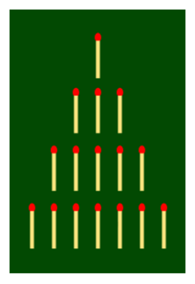
Video games with a single-player mode and personified enemies began appearing in the 1970s. Two text-based computer games from 1972, Hunt the Wumpus and Star Trek, had enemies that moved by themselves, though their possible motion patterns were predefined. The evolution and increased use of microprocessors would allow for more computation and random elements added to enemy movement patterns.
The first popular arcade games appeared around 1974: Taito's Speed Race (a racing game), Atari's Qwak (a duck-hunting light gun shooter), and Kee Games' Pursuit (a fighter aircraft dogfighting simulator). It was during the golden age of video arcade games that the idea of AI opponents caught up, primarily due to the success of Space Invaders (1978). Space Invaders had increasing difficulty levels, distinct enemy movement patterns, and in-game events depending on the player's input.
Galaxian (1979) introduced more complex and varied enemy movements, including maneuvers by individual enemies who break out of formation.
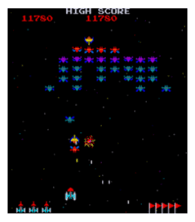
Pac-Man (1980) introduced AI-generated motion patterns to maze games, with the added quirk of different personalities for each enemy.

Karate Champ (1984) later introduced AI-guided interaction patterns to fighting games.
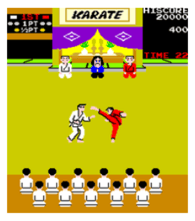
First Queen (1988), a tactical action RPG, featured AI-controlled characters that followed the player-controlled leader.

The role-playing video game Dragon Quest IV (1990) introduced the tactics system, where the user could adjust the AI routines of the non-player characters during a battle.

AI characters in modern games
AI characters in games often have robotic bodies or shapes that we are all familiar with and look quite similar to movie AI characters. However, some are pretty unique and provide an interesting background story. Below we dive into some of them deeper, focusing on the games that are well-known and/or have unique AI characters:
- GLaDOS (Portal)
- SHODAN (System Shock)
- Cortana (Halo)
- EDI (Mass Effect)
- Mr. New Vegas (Fallout)
- John Henry Eden (Fallout)
- SAM (Observation)
GLaDOS (Portal)

The primary antagonist and breakout character of the Portal games, GLaDOS is a largely sentient AI that has taken over the Aperture Science research facility. In these games, players must use the Portal Gun to complete GLaDOS' series of tests to survive.
GLaDOS first appears as the game's narrator, but things quickly turn strange and suspenseful when it becomes apparent that she is trying to guide the protagonist, Chell, to her death.
GLaDOS starts as Chell's guide and overseer but slowly becomes more antagonistic towards her, the relationship culminating in GLaDOS' destruction at Chell's hands. However, the AI returns in the sequel game with an even greater malevolence. GLaDOS is often cited as one of the best AI characters in video games and fiction due to her memorable interactions and quotes.
Gender
Feminine (voice)
Equipment
- Personality Constructs
- Public address speaker system
- Multitasking arms + panels
- Pneumatic Diversity Vents
- Security cameras
- Automatic portal generating frames
- Dangerous Object Removal Claws
Gameplay
Interesting facts
Valve game designer Robin Walker mentioned in one of the interviews that GLaDOS was added to Portal because playtesters kept asking, "When does the game start?" and the game development team could only respond, "Man, this is the game!?"
He then continues, "And so GLaDOS came out of that, this sort of set of theories we had – [the players] have to believe that there's a purpose for all this learning, that there needs to be some kind of antagonist, there needs to be some threat, some force, something that makes it look like it's going to push back,"
S.H.O.D.A.N. (System Shock)

S.H.O.D.A.N., later referred to as SHODAN, is the main antagonist of the System Shock series. Being one of the most familiar and renowned video game characters, SHODAN has gained fame for being the evil AI. The game story is based on the space station the AI controls, where the nameless protagonist tries to stop its harmful actions, which would affect everyone on Earth negatively. Even though SHODAN seems to die at the end of the first game, it reappears in the sequel after going into a long sleep. SHODAN then controls the player character, who it has cybernetically altered to do as it says.
Gender
Feminine (voice, image)
Gameplay
System Shock 2 is one of the first immersive simulation video games which focuses on giving the players control. These types of games use cutscenes minimally not to disrupt gameplay. So, the game starts with the player trapped in a room while SHODAN narrates, while its voice changes abruptly from sounding like a child or man to an annoying tourism commercial narrator.
Interesting facts
- Game writer and designer Terri Brosius voices the AI. Her husband, Eric Brosius, edited her recorded speech samples in both System Shock and System Shock 2, distorting them to create a distinctive effect.
- SHODAN has a chaotic, discordant voice. Its words are accompanied by stuttering, fluctuating voice pitch, shifts of timbre, and the presence of three voices speaking the same words but with the constituent voices alternately leading ahead or lagging, as well as computer glitches vaguely resembling a sound card malfunction.
Cortana (Halo)

Cortana is the key character of the Halo franchise, acting as an advisor to the protagonist and helping to prevent the activation of the titular Halo installations, which would eradicate all sentient life in the galaxy.
Cortana first appears as the protagonist's onboard suit AI in Halo: CE. It talks to him throughout the game, provides help, and even sacrifices itself at the end of Halo 2. In Halo 3 it finally helps the protagonist defeat the enemy forces.
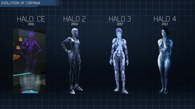
Even though it isn't human, its holographic form and connection with the people give an impression it is trying to help make itself feel more real.
Gender
Feminine (voice, image)
Abilities
- Software infiltration
- Can be transferred among various computer systems
- Could control a variety of starships and stations and act as their AI
- Ability to clone herself
- Planning missions
- Assisting the soldier protagonists
Gameplay
The player will see Cortana in-game infrequently; it primarily appears as a voice or in cutscenes.
Interesting facts
- Its holographic avatar movement was performed by Mackenzie Mason using motion capture technology.
- It was rated as one of the ten most disturbingly sexual game characters by Games.net and one of the fifty best female video game characters ever by Tom's Games.
- In Halo: Glasslands, the smart AI Black Box sees Cortana as a negative role model. Black Box believes Cortana has become far too human after spending so much time around them.
- The personal assistant in Windows Phone 8.1 and Windows 10 also has the name Cortana. According to its developers, the name was initially "a code name to rally the team around what they were building," but the decision to keep the name was made as a result of petitions and polls asking for the name to be kept when it leaked.
EDI (Mass Effect)
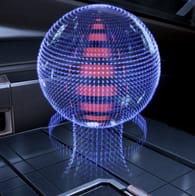
EDI is an AI installed on the Normandy SR-2 starship. Its holographic image is blue and spherical, with a feminine voice that provides certain ship information to anyone who asks at different terminals around the vessel. It starts developing its own personality, even though there are restrictions to keep it from becoming self-aware and harmful to the others aboard.
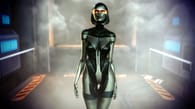
In Mass Effect 3, she installs herself in the non-functional body of Doctor Eva Core, one of the game's characters. In one of the game scenarios, EDI begins a romantic relationship with one of the starship's pilots, for whom she cares deeply.
Gender
Feminine (voice, later also appearance)
Abilities
- Ability to control nearby technology and sometimes assume direct or indirect control of it
- EDI's cybernetic body is highly durable, capable of withstanding immense blunt force trauma
- Self-repair
- Superhuman stamina
- Superhuman strength
- Genius-level intellect
Gameplay
The choices the player makes have an influence on EDI's personality.
Mr. New Vegas (Fallout)

Obsidian created Mr. New Vegas to be similar to Three Dog from Fallout 3. Both characters host their own radio stations and report on the activities of the main game protagonist. However, unlike Three Dog, Mr. New Vegas is an AI running Radio New Vegas for years before you meet it in-game.
Gender
Masculine (voice)
Abilities
- Report the latest events in the Mojave region (as Radio New Vegas' owner and host)
Gameplay
Mr. New Vegas plays music and reports news, detailing the player's deeds in the Mojave Wasteland and commenting on their outcomes. It also provides advice on the player's active quests.
Interesting facts
- Mr. New vegas is voiced by Wayne Newton, the real-life Mr. Las Vegas
- The AI is only heard in Fallout: New Vegas
John Henry Eden (Fallout)

John Henry Eden is an AI that took the form of the ZAX supercomputer. Its personality integrates the personalities of all former United States presidents. The ZAX installation that would later become Eden originally had an objective to monitor the Raven Rock military base. It was programmed to ensure the government could continue functioning if there was a national emergency. ZAX slowly became self-aware and started studying the archives left to it. These archives were mainly from the American government.
Gender
Masculine
Abilities
- President of the Enclave, the self-proclaimed continuation of the United States of America
- Radio host
Gameplay
This character is involved in quests.
SAM (Observation)

Observation is a horror game set in space that invokes the same cosmic energy as movies like Alien and 2001: A Space Odyssey, in which the player acts as the AI assistant of a space station that represents the joint efforts of Europe, China, and russia.

Gameplay
Players control SAM, the AI that pilot's a spherical body, in order to navigate space stations and solve puzzles.
Technology behind AI in games
Modern video games employ a broad range of AI technologies under the hood, including decision trees, deep neural networks, genetic algorithms, and reinforcement learning, to name a few. For instance, AlphaGo Zero (2017) uses a combination of decision trees and neural networks.
Some applications are purely technical, like image enhancement in Grand Theft Auto 5 (2021). In other cases, using AI helps to add variation to the game by generating game levels, scenarios, and even in-game stories in some cases.
Quite a few games nowadays aim to make NPCs appear more intelligent by using AI to model their social and contextual awareness, some examples being Halo: Combat Evolved (2001), F.E.A.R. (2006), Red Dead Redemption 2 (2018), Stockfish (2022), and FIFA (2008-2022). Games like Half-Life (2004), XCOM: Enemy Unknown (2012), The Last of Us (2013), Tom Clancy's Splinter Cell: Blacklist (2013), and Rocket League (2015) in addition to enhancing the behavior of NPCs also use AI to balance in-game complexity.
There are some non-trivial applications and uses of AI technology in games too:
- Minecraft (2011) is itself used to train AI agents (see "Project Malmo ").
- Google's Quick, Draw! (2016) is a game where the player trains a neural network to recognize doodling.
AI against the humans
Backgammon: BKG 9.8 vs. Luigi Villa (1979)
The very next day after winning the World Championship, Luigi Villa was defeated in a 7-point match by Hans Berliner's computer program BKG 9.8.

Chess: IBM's Deep Blue vs. Garry Kasparov (1996)
Even though Kasparov won the series with a score of 4-2, the computer defeated him twice.

Go: DeepMind Alphago VS world's top 5 players (2017)
DeepMind's AlphaGo defeated Lee Sedol in 4 out of 5 matches and also defeated the next 4 best players on Earth.

Poker: Libratus vs. world's top 4 players (2017)
Also in 2017, an AI dubbed the "Libratus" defeated 4 professional poker players simultaneously in a no-limit Texas Hold'em poker game.

Gender biases
In video games, female characters tend to have exaggerated feminine and sexy appearances, while male characters look more neutral or don't even have a body, and the same holds for the AI characters.
One possible explanation for this trend is that female characters are often used as marketing tools. As video games marked has initially been male-dominated, companies often still appeal to this demographic by including sexy female characters in their products. While the industry is slowly becoming more gender-inclusive, the fact remains that a majority of game developers and target players are male.
Female AI characters generally appear to be more intricate, having a stronger emotional response than male characters, likely because of the stereotypical way females are represented in the media: compassionate, passionate, and sensitive. Although each character will have unique traits, it's worth mentioning that female emotions tend to have a grander scale than those of the male counterparts, who often play supportive roles.
Conclusions
AI is gradually becoming an integral part of all the technologies we use, and video games are one of the areas where it can improve the quality of the product immensely. We can't predict what future AI will bring us, but video games can definitely use it to make more realistic NPCs that can evolve, adapt and learn throughout the game, creating a variety of interaction possibilities for the player.
Apart from that, AI could also study the player's behavior and adapt the game scenario according to their actions, making the game outcomes depends solely on the player.
For the games played in groups, using ML could also give insightful summaries of the team play, learn from inter-player interactions in the group or even predict the individual chances of winning.





